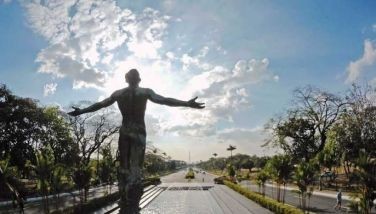Woes still hound RP environmental laws
MANILA, Philippines - The problem of effective enforcement of environmental laws does not only concern the police and prosecutors, but the judiciary.
At the opening yesterday of the Forum on Environmental Justice: Upholding the Right to a Balanced and Healthful Ecology at the University of the Cordilleras in Baguio City, Chief Justice Reynato Puno said although the country has enough laws to protect the environment, “the big challenge is how these hard and soft laws can be effectively implemented.”
Puno said the Philippines has over 170 environmental treaties covering diverse problems as acid rain, hazardous waste trade, ocean pollution, endangered species, trade and protection, and climate change.
But the courts, he said, are hounded by how they should set the threshold on locus standi (in law, the right to bring an action).
Citizens’ suits are now allowed in most jurisdictions, he added.
The chief magistrate said it used to be that “the citizen who seeks to intervene in an administrative proceeding or bring a complaint before the judiciary is shunted aside as a busybody or crank, and a whole arsenal of legal weapons are wheeled out against him.”
The implementation of public interest, he was told, must be left “to those who know best.”
But Puno said in the benchmark case of Oposa v. Factoran, “we broke new ground and relaxed the rule on standing and allowed environmental suits initiated in behalf of generations yet unborn.”
“We recognized the budding principle of inter-generational equity which assures each generation the right to receive the planet in no worse a condition than received by the previous generation and views the environmental and resource conservation obligations of the present generation from that perspective,” he said.
“The relaxation of the rule on locus standi has also its downside. Fears are expressed that this will open the floodgate to environmental litigations, many of which may be groundless, especially those filed by bounty hunters,” Puno said.
He feared these can drive away investment and can contribute to the over clogging of our green court dockets, while to strike back, damage suits can be filed against citizens initiating environmental complaints to dissuade them from acting like white knights of the people.
“Our task is to craft a rule that will strike the proper balance between the need to encourage citizen’s suit and the danger that unregulated citizen’s suit may bring about nuisance cases.”
Puno went on to identify how to minimize delays in the resolution of environmental cases, now numbering about 3,000.
Delays discourage the filing of cases to enforce environmental laws, the chief justice said.
He declared “current rules appear ill-suited to resolve complex and complicated environmental disputes because they are too technical and leave too little wiggle space for litigants to settle their dispute.”
“We should consider the use of negotiation, mediation and conciliation in environmental disputes to shorten litigation,” he said.
Puno, a champion of mediation, said a consensual approach to environmental dispute resolution is better than the conventional adversarial process.
“In contrast to litigation, negotiation relies upon the principals to create the terms of the final outcome,” he said.
The principals, he continued, bring to the bargaining table a much deeper understanding of the technical and institutional dimensions of environmental problems than is generally possessed by judges.
Another problem, Puno said, is procuring evidence and crafting effective remedies, pointing out that some prosecutors complain about the difficulty of prosecuting violations of environmental laws.
“They may be right,” Puno admitted. “It is time to re-examine our rule on confidentiality of information from our regulatory agencies and our rule on disputable presumptions within the constraints of due process, with the end in view of easing the burden of proof in prosecuting environmental cases.”
The problem is complicated, he said,
Resident Representative of the UN Development Program Sarah Timpson explained, “Science does not yet have the answers to our environmental riddles. It is frequently impossible to prove damage, in terms more conclusive than statistical probabilities.”
“We don’t know why a large chunk of Antarctica has broken free, what this may mean in terms of damage to the environment, or who to blame. Nor can we really predict the impact of future technologies, consumption patterns, new materials and other factors of critical importance for environmental policy.”
Meanwhile, a local waste and pollution watchdog urged the so-called green courts designated by the Supreme Court to prioritize “precautionary measures over unacceptable risks” and the “primacy of human and ecological health over corporate profit” in dispensing environmental justice in the country.
The Ecological Waste Coalition (EcoWaste) said the adoption of the “precautionary principle” by the green courts is one of the pillars of environmental justice since it is the act of prioritizing the common good to avoid toxic threats to human and ecological health, despite lack of scientific certainty.
Manny Calonzo, president of EcoWaste, noted that instilling the precautionary principle must be “a non-negotiable element of environmental justice” especially among judges, prosecutors and enforcers.
“This will involve all pillars of justice acting together to prevent serious or irreversible damage to public health and the environment, despite lack of scientific certainty,” Calonzo said.
“Also, this will require the proponent of a project, rather than the community, to bear the burden of proof as to the safety and soundness of a project that can potentially lead to toxic harm or environmental degradation,” he added.
Eileen Sison, of the Institute for the Development of Educational and Ecological Alternatives, stressed that it is the responsibility of the environmental courts to guarantee swift resolution of environmental cases such as those against polluting dumpsites.
According to Sison, environmental justice seeks to provide all people, whether rich or poor, with equitable and sustained access to public goods such as clean air, safe water, nutritious food and toxic-free environment that are essential to humane and decent quality of life.
“The green courts should act with speed to resolve the cases brought to them. We no longer have the luxury of time when it comes to environmental issues. Tardy judicial process can lead to costly rehabilitation of affected sites or, worse, irreparable damage to public health and the ecosystems. Environmental justice delayed is environmental justice denied,” Sison said.
EcoWaste earlier cited the dismal implementation of the Ecological Solid Waste Management Act of 2000, or Republic Act 9003, as a “blatant case of environmental injustice.”
The law, which took effect in 2001, prohibits open dumping and has directed the closure of open dumpsites in 2004 and controlled dumpsites in 2006.
But EcoWaste stressed that illegal dumpsites remain in service until today despite its ban under RA 9003. – Artemio Dumlao, Katherine Adraneda
- Latest
- Trending
































